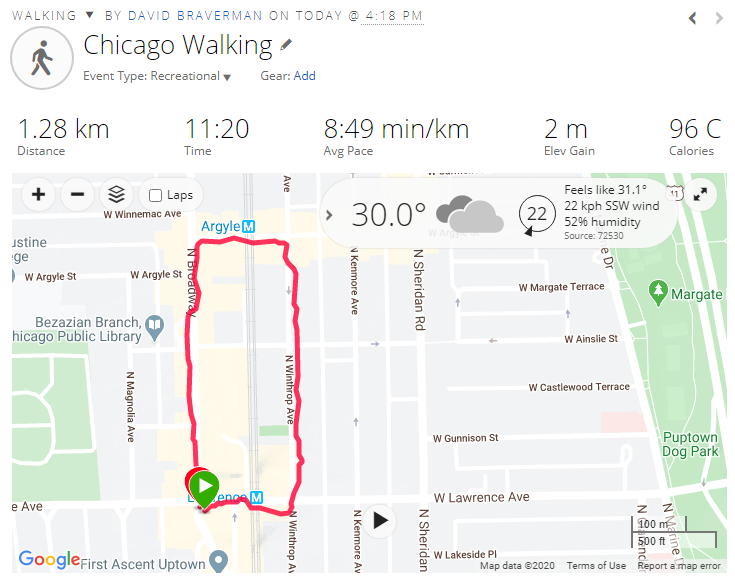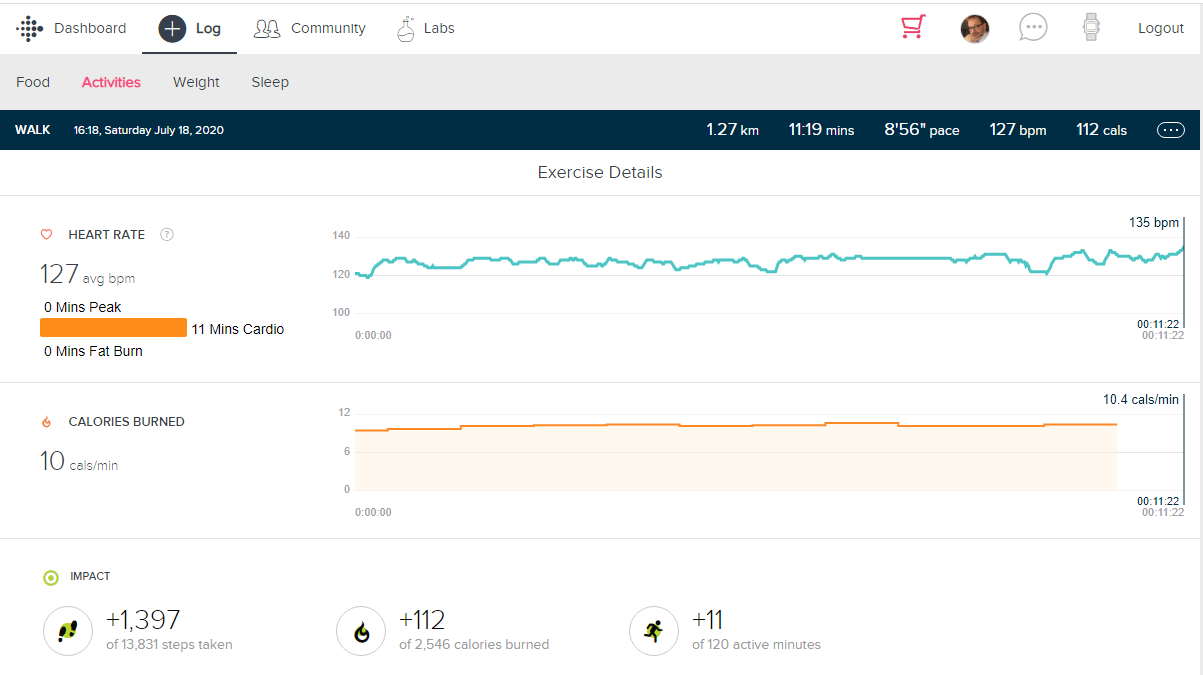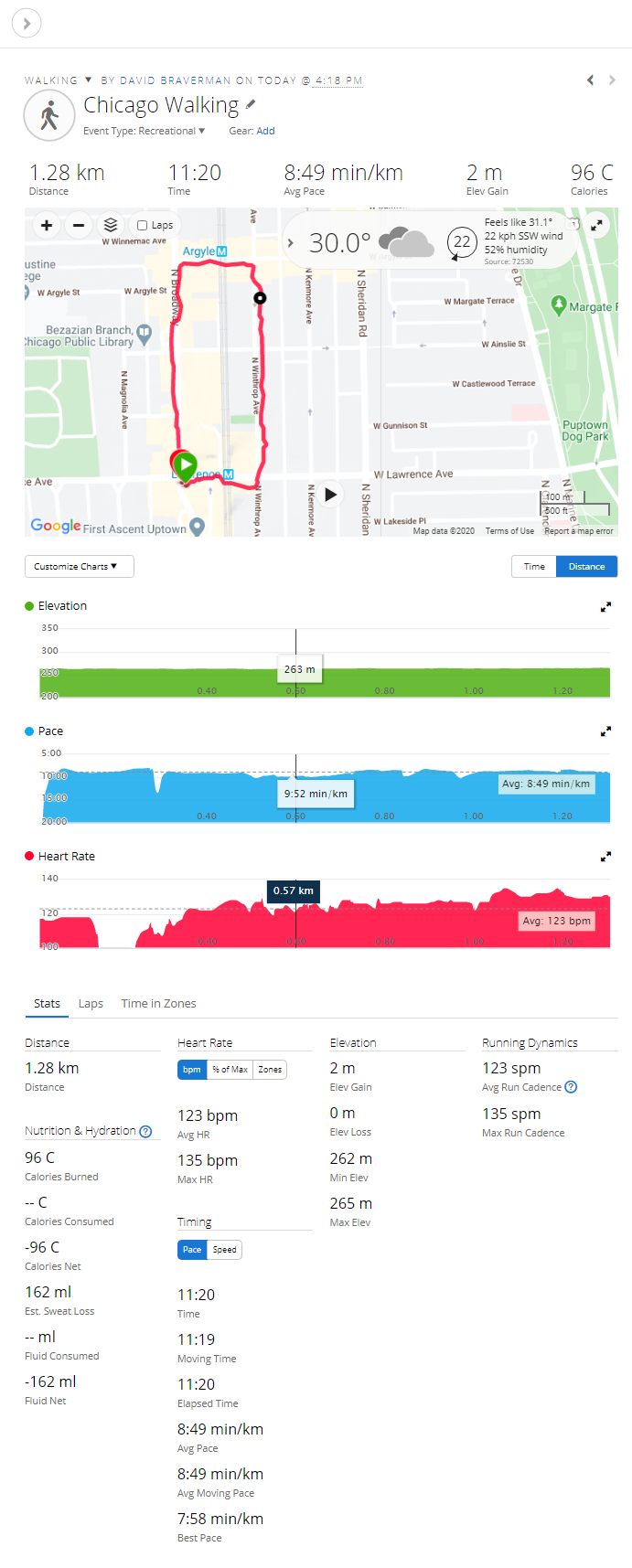Despite the Garmin Venu handing the Fitbit Ionic its ass in my first test of exercise tracing, the Fitbit didn't fail completely in sleep tracking.
Based on my self-perception of how well I slept, including my (and Parker's) acute awareness of the squall line that pushed through around 6:30, I think the Fitbit might have recorded my awake time more accurately. The Garmin, however, also recorded pulse oxygen, respiration, and can display movement on the UI.
Here's the Fitbit results:

And Garmin:

Also, yesterday my Fitbit counted 18,206 steps to the Garmin's 12,142—but I put the Garmin on my wrist at 1pm. Adding the 6,963 the Fitbit recorded before 1pm, that means the Garmin and Fitbit differed by (19,105 – 18,206 = ) 899, or 4.7% for the 11 hours between 1pm and midnight. Today I'm using both of them, though I switched wrists (yesterday the Garmin was on my dominant side; today it's not).
The thunderstorms from earlier have pushed on through the area, so once I digest my omelet and my Garmin fully charges, I'll do a longer test of exercise tracking.
Yeah, the Garmin wins, hands down.
After realizing that my first head-to-head test pitted an Ionic whose GPS was failing against a treadmill exercise, I went out for a quick loop around the block with both trackers correctly set to "Walk."
The Garmin found a GPS signal in about 20 seconds. The Fitbit never did.
After the walk, the Garmin produced this delightful map, complete with weather report and options for different maps:

Right on the activity view, I've got a gear icon with these options:

Fitbit only exports TCX files. Or you can export your entire account archive, become a programmer like me, parse your archive, and extract the relevant item.
But the map and export options just scratch the surface. Look what the Fitbit Web app gives me for this walk (since it didn't have GPS):

And here's the Garmin:

I mean, that's not even fair. Garmin even gave me the weather report, fer gassake. (It did not give me the step count for the activity, though.
Yeah. Fitbit, you were great, but I've grown; you haven't. You fell so far behind Garmin that I don't know how you're going to catch up.
Tonight, I'll see how differently they track sleep. And I hope that I can re-import today's Fitbit steps, else I'll lose the 7,000 I had before I set up the Garmin. Also, Garmin only imports step counts, intensity times, and body mass from Fitbit, not sleep data, so I'll have to find a different solution for that.
I have argued with Fitbit customer service for about as long as I've had a GPS-enabled device, to no avail. Their GPS chips die slowly until they die abruptly. And every time I've complained, they've instructed me on how to get a clean GPS reading. I've noted at those times that my phone, camera, car, and drone all connect to GPS within a few seconds (even from cold start), while my Fitbit Ionic can't connect no matter how long I let it try to find satellites. Or it does this:

I've even tried to troubleshoot this problem for them. I've run experiments on my Fitbit: battery level, sky conditions, clock synchronization (my Fitbit clock is almost always a few seconds behind GPS time). Nothing.
So you know what? I'm done with Fitbit.
Today I received a Garmin Venu, and in the first three hours of owning it, I've realized how far Fitbit is behind Garmin in technology:
- The Fitbit only has GPS, and it almost never works. The Garmin has GPS, Galileo, and GLONASS. (You get to use two at once.)
- Fitbit syncs time from phone; Garmin from GPS.
- Fitbit's software has maybe half the features as Garmin's.
- Fitbit has no concept of time zones, so all their data are stored as simple date-times, meaning traveling between time zones screws up your counts unless you take specific steps ahead of time. Garmin knows what a time zone is.
Plus, Garmin made it trivially easy to import all my step records, so I get to keep my personal records. (July 2018 was intense.)
I will say this, though: the Garmin led me down a garden path when I first tried to record exercise. I wanted to test the mapping features alongside the Fitbit, so I set them both to record walks and started a 3 km blast through my neighborhood. The Fitbit never connected to GPS, and the Garmin thought (for reasons I don't understand) that I was on a treadmill.
I'm about to try again, but with a shorter walk, because it's brutally hot out there.
The civil rights activist and long-time Member of Congress died yesterday of complications from pancreatic cancer:
On the front lines of the bloody campaign to end Jim Crow laws, with blows to his body and a fractured skull to prove it, Mr. Lewis was a valiant stalwart of the civil rights movement and the last surviving speaker at the historic March on Washington for Jobs and Freedom in 1963.
More than a half-century later, after the killing in May of George Floyd, a Black man in police custody in Minneapolis, Mr. Lewis welcomed the resulting global demonstrations against systemic racism and the police killings of Black people. He saw those demonstrations, the largest protest movement in American history, as a continuation of his life’s work, though his illness had left him to watch from the sideline.
Mr. Lewis’s personal history paralleled that of the civil rights movement. He was among the original 13 Freedom Riders, the Black and white activists who challenged segregated interstate travel in the South in 1961. He was a founder and early leader of the Student Nonviolent Coordinating Committee, which coordinated lunch-counter sit-ins. He helped organize the March on Washington, where the main speaker on the steps of the Lincoln Memorial was the Rev. Dr. Martin Luther King Jr.
Mr. Lewis led demonstrations against racially segregated restrooms, hotels, restaurants, public parks and swimming pools, and he rose up against other indignities of second-class citizenship. At nearly every turn, he was beaten, spat upon or burned with cigarettes. He was tormented by shrieking white mobs and absorbed body blows from law enforcement.
On March 7, 1965, he led one of the most famous marches in American history. In the vanguard of 600 people demanding the voting rights they had been denied, Mr. Lewis marched partway across the Edmund Pettus Bridge in Selma, Ala., into a waiting phalanx of state troopers in riot gear.
Lewis represented Georgia's 5th district from 1987 until his death yesterday.
It's 31°C but feels like 32°C right now, which will seem almost comfortable this time tomorrow:
It could feel as hot as 41°C degrees this weekend in Chicago.
The city will get hit with high temperatures and humidity Saturday and Sunday, which could prove dangerous for some residents.
[T]emperatures will rise to 34°C Saturday and 33°C Sunday. Both days will be sunny with high humidity and a chance of rain. The heat and humidity could make it feel like it’s 38-41°C during the day, according to the National Weather Service.
We're already having the third-hottest summer on record (so far), and we're only a little past halfway done. The year 2020 continues to find more ways to suck.
The new political theory of "executive underreach," defined as "a national executive branch’s willful failure to address a significant public problem that the executive is legally and functionally equipped (though not necessarily legally required) to address," only partially explains the willful idiocy of Republican actions in the past 24 hours.
Exhibit A: White House Press Secretary Karen Kayleigh McEnany "won't let science get in the way" of schools reopening, whether they want to reopen or not:
Exhibit B: Georgia Governor Brian Kemp has sued Atlanta Mayor Keisha Lance Bottoms to enjoin the city from enforcing its mandatory mask regulation, following his executive order earlier in the week banning such mandates. Even the Trump-hobbled Centers for Disease Control and Prevention says everyone who's able should wear one. But Kemp will not be stopped from stopping this fascist infringement on the God-given rights Georgians have to kill their parents and friends as cases continue to rise in the state.
I can handle it fine when Republicans troll us with outrageous policies that are immoral, unconscionable, and just plain evil. But this? This is stupid, and the virus doesn't care. We can fix policy with policy. We can't fix disease transmission with stupidity.
We need to vote every single one of these people out of office in November.
Oregon Public Broadcasting is reporting this morning that last night, two Federal agencies using unmarked cars have started pulling people off the streets:
Federal law enforcement officers have been using unmarked vehicles to drive around downtown Portland and detain protesters since at least July 14. Personal accounts and multiple videos posted online show the officers driving up to people, detaining individuals with no explanation of why they are being arrested, and driving off.
The tactic appears to be another escalation in federal force deployed on Portland city streets, as federal officials and President Donald Trump have said they plan to “quell” nightly protests outside the federal courthouse and Multnomah County Justice Center that have lasted for more than six weeks.
Officers from the U.S. Marshals Special Operations Group and Customs and Border Protection’s BORTAC, have been sent to Portland to protect federal property during the recent protests against racism and police brutality.
But interviews conducted by OPB show officers are also detaining people on Portland streets who aren’t near federal property, nor is it clear that all of the people being arrested have engaged in criminal activity. Demonstrators like O’Shea and Pettibone said they think they were targeted by federal officers for simply wearing black clothing in the area of the demonstration.
Charlie Pierce calls this "being softly Pinochet'ed in broad daylight" (despite the arrests happening at night):
LEO’s in camo? Unmarked vehicles? Disappearing people off the street without charge? Detention in something far too close to a police black site? (Ask some folks in Chicago how those work out.) I always knew I missed something not growing up in Santiago.
Why in the hell is this not a bigger story? A major American city is being softly Pinochet’ed in broad daylight. And, if we know one thing, if this president* and his administration* get away with this, it will only get worse. You’d have to be out of your mind—or comatose since the Fall of 2016—not to suspect that this could be a dry run for the kind of general urban mobilization at which the president* has been hinting since this summer's protests began.
Also on Thursday, press secretary Kaleigh McEnany took a moment out of her briefing to call Chicago Mayor Lori Lightfoot a “renegade mayor” because Lightfoot refuses to ask for the National Guard to come into her city. (To her credit, Lightfoot snapped right back.) The White House is on record several times as trying to delegitimize Muriel Bowser as mayor of Washington, D.C.
Portland may be a dumbshow for dummies, but it also looks like a dress rehearsal. This is not an "authoritarian impulse.” This is authoritarian government—straight, no chaser.
The good news, if we can call it that, is that 56% of Americans and 55% of likely or registered voters disapprove of the administration.
The most destructive man-made force in the history of the planet exploded for the first time 75 years ago today:
On July 16, 1945, at 5:29:45 a.m., the Manhattan Project comes to an explosive end as the first atom bomb is successfully tested in Alamogordo, New Mexico.
The scientists and a few dignitaries had removed themselves 10,000 yards away to observe as the first mushroom cloud of searing light stretched 40,000 feet into the air and generated the destructive power of 15,000 to 20,000 tons of TNT. The tower on which the bomb sat when detonated was vaporized.
The Alamogordo blast tested the "Fat Man" implosion design that compressed two hemispheres of Pu-239 around a U-235 trigger through a perfectly-timed set of high explosive detonations around the sphere. This resulted in almost 40% more yield than the gun-type "Little Boy" design that exploded over Hiroshima, Japan, three weeks later. The second "Fat Man" exploded over Nagasaki, Japan, three days after that.
In 1952, the United States demonstrated a fusion bomb that produced 450 times more yield than the Nagasaki explosion, igniting an arms race that ultimately led to the USSR developing a 100 MT "Tsar Bomba" that, were it detonated over O'Hare, would produce a fireball completely vaporising the airport and surrounding villages, would destroy any masonry or wood-framed buildings from Mundelein to Oak Lawn and St Charles to the Loop, and would cause third-degree burns to any exposed flesh in a 74 km radius encompassing Kenosha, Channahon, De Kalb, Gary, and more than halfway across Lake Michigan.
The half-strength (!) Tsar Bomba tested on 30 October 1961 remains the most destructive weapon ever demonstrated on earth.
The United States remains the only country to have prosecuted a nuclear war against another country.
In a side note, the nuclear bombings of Hiroshima and Nagasaki killed an estimated 100,000 people outright and perhaps another 50,000 people over the following year due to secondary effects like radiation sickness and disease. This is only 10,000 more than the number of Americans killed by Covid-19 since March.
Writing in the Independent UK, Chicago-based Noah Berlatsky argues that state leadership has made Illinois a lot better off than, say, Florida:
Illinois' achievement is both a model and an accusation. It points a way forward for other states. It also shows that the disaster facing the country now was thoroughly preventable.
State officials in Illinois have managed to contain the virus by acting early, aggressively, and imaginatively. In mid-March, with only about 100 cases in the state, Chicago's Mayor Lori Lightfoot cancelled the annual St Patrick's Day Parade, and Governor J B Pritzker closed schools. He delivered a shelter-in-place order on March 20.
At the same time, before the the caseload had reached crisis levels, Pritzker brought in proactive measures to increase healthcare capacity. He called retired doctors and nurses to return to work. He also ordered McCormick Place convention center to be converted into a 3,000-bed field hospital — a step that proved unnecessary, but which shows how seriously he took the crisis. The state worked ceaselessly to increase testing, and by early June had enough capacity that anyone in the state concerned about their Covid status could get a test. From less than 10,000 tests a day in April, the state now tests almost 40,000 people daily.
Pritzker's aggressive, multi-pronged efforts to promote masking, social isolation, testing, and healthcare capacity stands in sharp contrast to the actions of governors like Florida's Ron DeSantis. In March, while Pritzker was closing schools and businesses, DeSantis left stay-at-home orders to local authorities, despite a rapidly rising caseload. Since then he's consistently downplayed dangers from the virus, even as cases have spiked over the last week. Disney World is reopening, just as many hospital report they have already run out of ICU beds. And deaths are slowly but ominously creeping up. Florida hit a one-day record high of 120 deaths from Covid on July 9.
Still, Pritzker has shown how much can be done statewide despite Trump's malevolent incompetence. Illinois has not done everything perfectly. But there's no doubt Pritzker has saved hundreds and perhaps thousands of lives. He's largely done the right thing for his constituents. In the coming weeks, I fear we'll see how badly DeSantis and other governors have failed theirs.
We're not perfect, though. Yesterday, while walking the 10 blocks down Clark Street from Addison to Surf, I counted 37 total zeros not wearing masks, 3 half-wits whose masks covered their mouths but not their noses, and 34 good citizens with full mouth and nose coverings. So we have some work to do.
Happy tax day! And now, we're off to the races:
Finally, Bloomberg takes a backward glance at the rise and fall of the Segway.